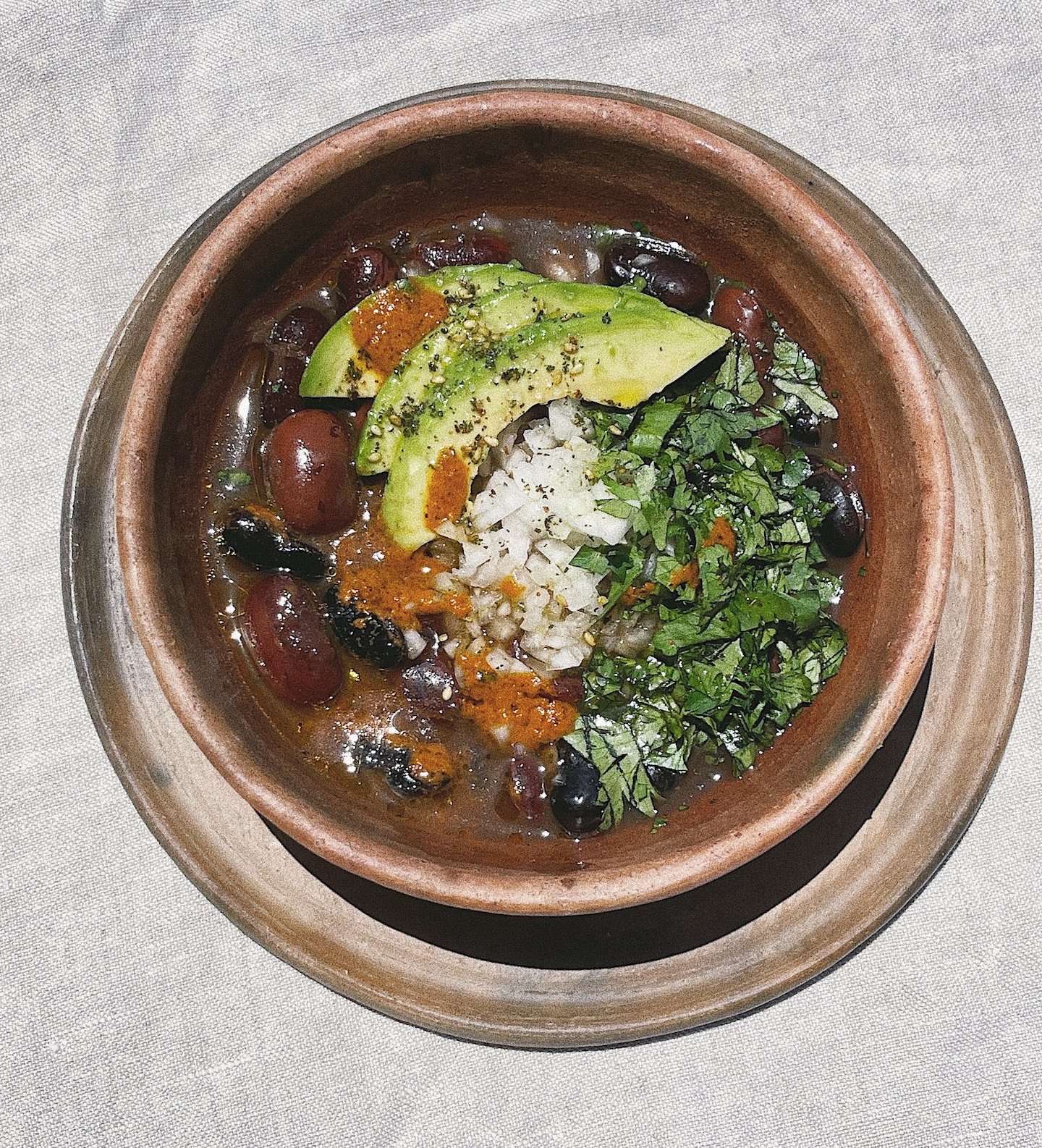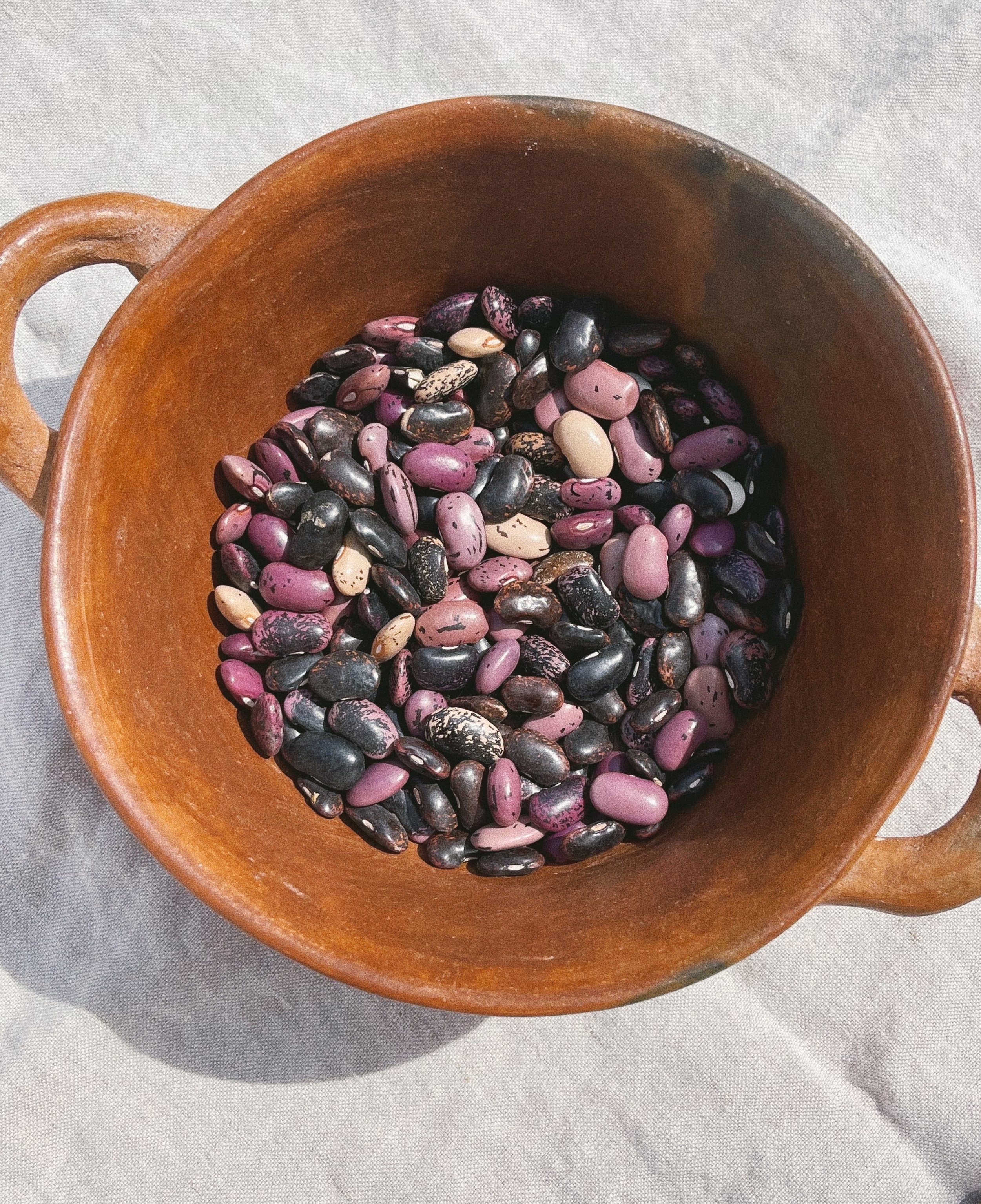SUNDAY RECIPE y UNA CANCIÓN: FRIJOLES DE LA OLLA
Andrea Aliseda is back with one of my go-to favorite dishes to make, Frijoles de la Olla (beans in a pot). She has also shared a Sunday Recipe Song and her connection to the song, is why I started our Sunday Recipe y Una Canción series. I am excited for everyone to have a taste of Andrea’s recipe and also her heartfelt writing.
Traditionally, Frijoles de la Olla is made using pinto beans. The flavor of pinto beans are forever etched into my tastebuds. So much so that whenever I see pinto beans, an image of my mom standing in the kitchen adding water to and stirring a pot of beans, immediately comes to life. Last week I was given a bag of beautiful scarlet runner beans, also known as multiflora or butter beans. They are hypnotic and I love to stare at them. I decided to use my gifted beans to make my Frijoles de la Olla.
In Andrea’s recipe she uses Jalepeños, I didn’t have any so I used dry Ancho and Morita chiles. . . I always have these chiles, a short reach away, in my kitchen. I topped my bowl of beans with spoonfuls of chopped cilantro and onion, sea salt, a squeeze of lime, olive oil and our NEW Morita Hot Sauce.
To me, the final flavor in a bowl of Frijoles de la Olla is the essence of Family Food Traditions. Every family has their special spice kit. Again, I see my mother; reaching into the cupboard to pull out her bag of mixed oregano, cumin, salt, pepper, spice blend (that she keeps a secret) and of course. . . her chiles.
love, April
SUNDAY RECIPE
Frijoles de la olla by Andrea Aliseda
“So many amazing bean dishes originate here, from molletes to enfrijoladas, but there’s something spectacularly beautiful about enjoying a humble bowl of beans.”
There’s nothing quite as comforting, or as central to a Mexican kitchen as Frijoles de la Olla. I recently wrote about my love for beans, for Whetstone Magazine, and how my siblings and I would devour my mom’s brothy beans she’d make in her traditional clay pot. So many amazing bean dishes originate here, from molletes to enfrijoladas, but there’s something spectacularly beautiful about enjoying a humble bowl of beans. It gives light to the bean’s true taste and texture, allowing themselves to be deliciously appreciated just as they are. Think of this recipe as more of a guide, and allow yourself to stray and sub alliums, herbs or chiles if desired, adapting to what you have on hand or in your proximity. Make these beans on days hot or cold, to soothe and comfort, to bask in celebration, or to simply add into rotation as you skim the magical repertoire of varietals of bean, bringing them to the forefront of our palates and tables, where they’re infinitely worthy of adoration by the loving spoonful.
Ingredients:
1 lb of beans (I used Domingo Rojo, but you can use any kind! Pinto would be super classic here!)
1 white onion, peeled and cut in half
3-4 small to medium garlic cloves, peeled
2-3 bay leaves
1 large serrano or jalapeño peppers, or 2 medium
1 dried ancho pepper, rinsed, deveined and de-seeded 2 sprigs of thyme (or your preference of herb)
14 cups of water, or 3 inches above beans
Sea salt to taste
To serve:
1 to 2 avocados, sliced
2 to 3 limes
Salsa macha (or another salsa, if desired)
Unsweetened cultured coconut yogurt (Cocojune yogurt is the best for this! We’re subbing for sour cream or crema Mexicana, feel free to opt for queso fresco or shreds of mozzarella instead)
Half a bunch of cilantro, leaves or rough chopped
This recipe makes about 5 to 7 servings.
Instructions:
1. To start, always clean your beans first. You can spread them on a sheet pan or large flat plate to check for rocks or other debris. You can also give them a rinse through a strainer afterwards to be extra cautious.
2. Though there’s much debate around soaking or not soaking, I am of the camp that believes they are most tenderly and speedily cooked when soaked. So for this recipe, soak your beans at minimum 3 hours, at maximum 24 hours. If you let them soak for longer than 12 hours, please change the water during its soak as to not ferment your beans. I let mine soak overnight, usually, so roughly around 12 hours.
3. After your beans have soaked and absorbed the water in their reposo (rest) to a plump and wrinkly shape, rinse them and be rid of the remnants of the water they’ve been slumbering in. Add them into your pot.
4. Now add your water. A broth will do you one better, creating more depth in flavor, but water will provide a clearer taste of the variety of your bean. You can add about 14 cups of water, or better yet, eyeball the level of the water to reach 3 inches above beans.
5. At this step, add in your alliums, like your garlic and onion, your bay leaves and chiles. Turn up your heat to a medium to medium high flame. Cover the pot but not fully, leaving a sliver exposed for the heat to escape like a crescent moon. Wait until your beans reach a simmer. Do not, for the love of god, salt your beans at this stage––it will harden them. I don’t know why, but my mom told me and it's proven true.
6. Once your beans reach a simmer, lower the flame to low, and add your first sprig of thyme. If you don’t have thyme, rosemary works. If you don’t have rosemary, use oregano. Whatever herbs you have on hand, will work wonderfully. However, if you want to add cilantro or a more delicate herb, I’d wait until we’re a bit further along to drop them in so that their flavor is at the forefront and the cilantro doesn’t get bitter in the cooking process. Cover the pot again, with the lid ajar and not completely sealed, and leave the beans to cook low and slow for about an hour. Put on a timer if you’d like, call your mom and say hi, or your friends and see how they’ve been, read a good book or write a sweet note, take it easy but don’t stray too far from the beans.
7. Once the hour has passed, be a good bean-tender and check on your beans. Have they softened? If yes, now is the time to add your salt. Add salt to taste and adjust as you go. At this point the leaves of my thyme sprig have fallen off their stem, yours may have too, take out the stem. Here’s when you can also add another sprig, or you may add cilantro at this time, take this as a guide for your brothy frijol de olla. I’ve reserved mine to dress my beans with to serve. You may also, if you don’t wish to have the rustic pleasure of the uber tender dried chile’s skin in your final bowl of beans, remove it now. I like to leave it, this is why I remove its seeds and devein, I find they become somewhat bitter in the process. Let them continue to cook low and slow for one more hour, allowing the salt to take hold and bring out the flavor of your beans. Again, leave the lid slightly ajar.
8. While you wait for your beans to cook for their last hour––and honestly if you want you can continue cooking them for another but this is a totally personal choice and depends on your type of bean and schedule, cooking longer will deliver a slightly more reduced liquid and more impregnated flavor (though I find this happens with the recalentados)––begin prepping their toppings. Pluck the leaves of your cilantro and reserve them, for a more distinct visual, the shape will look like a lily pad floating atop your oval jewels. Save the stems for a future broth! If you’re more practical and desire more cilantro to come through with its freshness, rough chop half a bunch and set it aside. Something else you can use is diced white onion, as a topping. But I forego it in this recipe, you’ll see why in a bit. Slice some avocado, and some limes in half, and save to serve.
9. Once your beans are ready, brothy and aromatic, serve yourself a nice bowl and marvel at their transformation, at their color and shape. Add in as much broth as desired. You see those super tender onion layers floating in the pot? They’re rich in flavor and melt in your mouth, add those in. Top your beans with coconut yogurt (or crema if you eat dairy), sprinkle some maldone flaky sea salt, add your sliced avocado, and drizzle some oily salsa macha of your choice (if you’d like!). Serve with a halved lime and a toasted buttered bread of choice, I had mine with pumpernickel and highly recommend(!), or some warmed tortillas de maíz (or harina!) and enjoy in a brothy bowl of the jewels of the earth.
Note: Have fun with your toppings, you can forego the crema/coconut yogurt and add queso fresco, panela, mozzarella or monterey jack. Instead of the salsa macha you can drizzle a chile or herb-infused oil. If you don’t like cilantro, add epazote. The bowl is your oyster.
Y UNA CANCIÒN
"Hijo de la luna is a novella strung into a 4-minute song, a Romani woman strikes a deal with the moon––she wants a lover, the moon wants her first-born in exchange. Like the song, beans hold stories, memories, nostalgia––albeit not always as fantastical. . . Making frijoles de la olla is not a quick endeavor, it's an odyssey from seed to tender meat, and it warrants a song that captures an odyssey of its own.
When I think of making frijoles de la olla, I think of my mom and the music she loved. Mecano was one of her favorite artists when I was young and their music was a familiar backdrop to our upbringing, from car rides to her cooking. Listening to them I see her in the kitchen with the radio turned up, belting the lyrics, completely in her zone. 'Hijo de la luna' is a novella strung into a 4-minute song, a Romani woman strikes a deal with the moon––she wants a lover, the moon wants her first-born in exchange. Like the song, beans hold stories, memories, nostalgia––albeit not always as fantastical. There's even a soft rattling in the background akin to the sound of moving pulses. Making frijoles de la olla is not a quick endeavor, it's an odyssey from seed to tender meat, and it warrants a song that captures an odyssey of its own.



